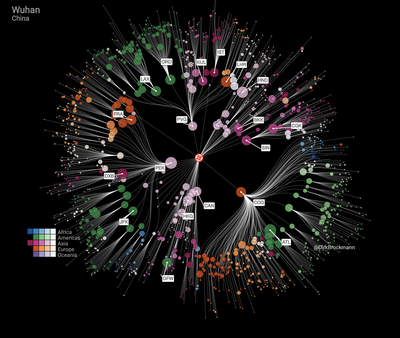Coronavirus: „A manifestation of globality“
The coronavirus is spreading, but the risks of infection are unevenly distributed throughout the world. Based on an analysis of data on worldwide flight connections, a team of researchers from the Humboldt-Universität zu Berlin (HU) and the Robert Koch Institute (RKI) headed by Prof. Dr. Dirk Brockmann have calculated the probability of an infected passenger from Wuhan arriving at any airport worldwide. The basis of the model is the worldwide air transport network (WAN), which connects approximately 4,000 airports with more than 25,000 direct connections.
Prof. Dr. Brockmann from the Humboldt Universität explains the model in an interview and explains why France is closer to Wuhan than Indonesia.
You have developed a risk monitor for the coronavirus. Germany currently stands at 14th place with a risk index of 0.139 per cent (as of January 31, 2020). How did you arrive at this result?
Brockmann: You have to think of it in this way: The model is a pure mobility model. That means, it considers global air traffic with approximately 4,000 airports and about 51,000 direct connections between the airports. We asked ourselves the following question: if 1,000 infected people in Wuhan board a plane – where does it land? Most passengers would land at an airport in China, but around 10 per cent would travel beyond national borders. We asked ourselves: how are they distributed among the different countries and these are then the relative import risks. Concretely this means the following for Germany: Of 1,000 infected people who boarded in Wuhan, about 1.4, that is, one or two people land in Germany. Germany currently has a relative import risk of 0.139 per cent, while the United States or France have a relative import risk that is about four times higher.
Why is that?
With the model we were able to calculate the probable propagation paths of the virus. And Charles de Gaulle Airport in Paris is a very important European node. This airport has an enormous significance from the perspective of Wuhan since there are direct flights and a lot of air traffic flow takes place here.
If, for example, we took Beijing as the place of origin, then the airport in Frankfurt am Main would be very significant, since there are many direct flights from Beijing to Frankfurt. For every place of origin, for every reference node, we can calculate the probable paths to all other airports from these reference nodes. And in this way the risk is calculated.
Which result surprised you the most – and why?
First, I was surprised that France is very high up in the rankings compared to the United States. On closer inspection, I realized that in this special case Charles de Gaulle Airport is an important hub. I was also surprised that the relative import risk of other Asian countries, which from the perspective of Wuhan are quasi ‘next door’, is distinguished only insignificantly from that of France or Germany. The relative import risk of France (0.242 per cent) is higher than that of Malaysia (0.202), Indonesia (0.154 per cent) and the Philippines (0.146). This result is also a manifestation of globality. From the perspective of Wuhan, France is closer than Malaysia.
This also reflects then Chinese trade relations with the rest of the world.
Exactly.
For whom are your prognoses useful?
With our model we supply figures to the Robert Koch Institute (RKI). The RKI can then inform politicians or hone their perceptions so that they are able to make the correct decisions. When all of Germany asks how, for example, the Frankfurt airport will react, our numbers also provide reliable data that can help in making decisions.
In an age of globalization, do we have to reckon with further pandemics in the future?
Pandemics, that is, global outbreaks of a disease, will continue to occur. On the one hand, an increasing number of people live in urban centres and, on the other, we eat a lot of meat and also keep a lot of animals – a relatively large number of these new viral infections come from animals. These are all factors that indicate that such situations will transpire at a higher rate.
Kathrin Kirstein asked the questions.
Further Information
- Website of Brockman Lab
- 2019 Novel Coronavirus Global Risk Assessment
- Model of aircraft movements from Wuhan airport
Contact
Prof. Dr. Dirk Brockmann
Institute for Theoretical Biology (ITB)
Department of Biology
Humboldt-Universität zu Berlin
Phone: +49 30 18754 2070
dirk.brockmann@hu-berlin.de

